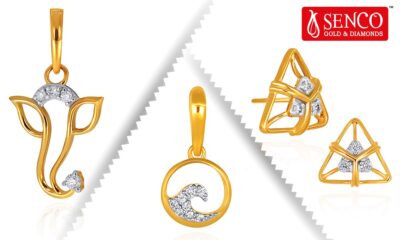National News
Jewellers Offer Affordable 18-Carat, 14-Carat Options as Gold Prices Surge
With Gold Prices Rising Sharply, Jewellers Adapt by Introducing More Budget-Friendly Jewellery Choices

Gold prices have seen a significant surge this quarter, crossing the ₹8,800 per gram mark, prompting jewellers to adjust their offerings to maintain customer demand amidst rising prices. The yellow metal’s price spike has been driven by global geopolitical tensions and trade uncertainties, leading many customers to reconsider their jewellery purchases during the busy wedding season.

According to Ramesh Kalyanaraman, the executive director of Kerala-based Kalyan Jewellers, “What happens usually is whenever there is a sudden spike of gold price or sudden fall of the gold price, the customer takes a pause to see the direction of what is happening. There have been three spikes almost in this (January-March) quarter. Of course, the pause cannot be more than 10-15 days.”
The price rise comes at a time when the wedding season is in full swing, a period which traditionally accounts for a large share of the jewellery industry’s revenue. Kalyanaraman notes, “almost 60 per cent of the revenue comes from weddings and related shopping.” However, he acknowledges that while customers may delay purchases in the short term, the wedding season eventually drives them to make purchases despite price fluctuations.
In 2024, gold prices increased by 26 percent, marking one of the best years for the precious metal. This surge had a tangible impact on jewellery demand, which declined by 2 percent to 563.4 tonnes in 2024 from 575.8 tonnes in 2023, according to the World Gold Council. Kalyanaraman adds, “customers typically walk in with set budgets. Therefore, when prices have gone up, their volumes may come down.”
In response to this shift, jewellers have introduced more affordable alternatives. For instance, Kalyan Jewellers has expanded its offerings in 18-carat gold, which provides a 15-20 percent price difference compared to 22-carat gold, making it more accessible to customers. “When you do 18-carat jewellery, there is a 15-20 per cent rate difference. That makes it more easy to buy jewellery even if the prices have gone up,” says Kalyanaraman.
Similarly, in the diamond jewellery segment, where gold is typically 18-carat, Kalyan has introduced 14-carat gold options to make products more affordable. This shift towards lighter, more budget-friendly pieces is part of a broader trend in the industry.
“We are also observing a shift in consumer preferences with a growing inclination towards lightweight, rose gold, and white gold, primarily among younger customers,” said Saurabh Gadgil, the Chairman and Managing Director of PN Gadgil Jewellers. “We also anticipate that by 2029, the demand for 18-carat gold will increase significantly, bringing further opportunities for growth in the industry.”

In terms of expansion, Kalyan Jewellers is planning to open 170 new showrooms in the upcoming financial year, including 90 under the Kalyan brand and 80 under its lifestyle jewellery brand Candere. Kalyan recently completed the buyout of Enovate Lifestyles, which operates the Candere brand, and is transitioning it to an omnichannel model. Kalyanaraman mentioned, “Candere is in a transformation phase. It was a 100 per cent digital company. The focus was completely online. From last year, we have started offline also. In the next financial year, we will start brand campaigns and store expansion will also happen.”
The company has set an ambitious ₹1,000 crore revenue target for Candere over the next 2-3 years. As part of its expansion strategy, Kalyan Jewellers is focusing on markets outside of southern India, with plans to open 75 of its 90 new Kalyan showrooms in non-southern regions, as well as international markets in the US, UK, and the Middle East.
National News
Gold loan NBFC stocks face pressure as gold prices decline

Gold loan NBFC stocks faced pressure as gold prices crashed, with Muthoot Finance and Manappuram Finance dropping 3% and 1.45%. Despite recent declines, both stocks show solid year-to-date gains of around 49% and 50%, respectively. Shares of Muthoot Finance slipped 4.29 percent to Rs 3,134.20 apiece on the NSE. The stock has declined for three straight sessions, losing nearly 6 percent during the period. Manappuram Finance also fell 2.8 percent to Rs 277.90 per share.
Gold prices eased for the third consecutive day as investors booked profits after a recent rally. Globally, the metal edged lower towards the $4,000-an-ounce mark amid concerns that its sharp gains had become overstretched. Weakness in gold prices typically weighs on gold financing companies as the value of collateral declines, impacting loan margins. Short-term challenges include potential slowdowns in loan disbursements and temporary margin pressure.
Gold loan NBFC stocks are facing pressure as gold prices have declined for three consecutive days. Muthoot Finance dropped 4.29% to Rs 3,134.20, losing nearly 6% over three sessions, while Manappuram Finance fell 2.8% to Rs 277.90. This decline comes as investors booked profits after gold’s recent rally toward the $4,000-an-ounce mark, with concerns that prices had become overstretched.
The connection between falling gold prices and these stocks is straightforward. Gold loan NBFCs lend money using gold jewelry as collateral, typically advancing around 75% of the gold’s value. When gold prices fall, the collateral backing their existing loans becomes less valuable, which squeezes their safety margins and creates potential risks. They may need to ask borrowers for additional collateral or close out some positions if the loan-to-value ratios become unfavorable.
Beyond the immediate risk concerns, falling gold prices also hurt the growth prospects of these companies. Lower prices mean they can only disburse smaller loans against the same quantity of gold, which directly impacts their ability to grow their loan books. Additionally, customers become hesitant to pledge their gold when prices are declining, preferring to wait for better valuations. This combination reduces both the size and volume of new loans.
However, the recent decline needs to be viewed in context. Despite the current pressure, both Muthoot Finance and Manappuram Finance are still showing impressive year-to-date gains of around 49-50%. This means the recent weakness represents a modest correction within a much larger uptrend. The stocks have performed exceptionally well throughout the year, and this pullback follows a period of strong gains.
Looking ahead, the key question is whether gold prices will stabilize or continue declining. Short-term challenges include potential slowdowns in loan disbursements and temporary margin pressure. However, gold loan NBFCs have weathered gold price volatility before, and their business model remains fundamentally sound with typically low non-performing assets. India’s deep cultural connection to gold ensures sustained demand for gold-backed financing regardless of short-term price movements. For investors, this situation could represent either a buying opportunity or a warning sign, depending on their view of gold’s longer-term trajectory.
-

 National News2 weeks ago
National News2 weeks agoSenco Gold & Diamonds launches affordable 9k gold jewellery starting under ₹7,000, a Game-changer amid fluctuating gold prices this Dhanteras
-

 GlamBuzz2 days ago
GlamBuzz2 days agoAbaran Jewellers conducts grand reopening of flagship showroom at J.P. Nagar South Bangalore
-

 National News21 hours ago
National News21 hours agoGold loan NBFC stocks face pressure as gold prices decline
-

 JB Insights2 weeks ago
JB Insights2 weeks agoJewellery industry optimistic despite rising gold prices










